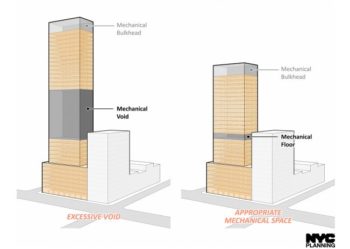
Building on left demonstrates the current issue with excessive mechanical voids. Image Credit: NYC CPC
The proposal discourages clustering mechanical voids in a way that inflates building heights. On January 28, 2019, the CPC announced the beginning of public review of the proposed rezoning plan to limit the use of excessive voids that artificially inflate tower heights in residential buildings. Currently, these voids, or multiple floors of empty space, are not counted as zoning floor area in the Zoning Resolution.
“Creating large, enclosed and empty spaces within a building for the sole purpose of making it taller and enhancing views of residents on the top floors is not what was intended by our zoning rules. This proposal offers a simple and elegant fix to ensure that apartment buildings produce housing, that their size is predictable for communities, and that they can’t play leapfrog with our skyline. We welcome innovative and beautiful architecture, not building features that are nakedly gratuitous,” DCP Director Marisa Lago said.
The new plan will limit this space to 25 feet and any mechanical space taller than 25 feet will be deducted from the maximum allowable floor area for the building. The proposal focuses on zoning districts R9 and R10 and equivalent zoning districts in the Bronx, Manhattan, and Queens, and seeks to restore predictability in building heights and less exploitation of zoning through these otherwise tall buildings in high-density residential neighborhoods.
“I want to thank the Department of City Planning and the de Blasio administration for responding to concerns from communities to close a zoning loophole which only serves to maximize building heights for luxury towers by inflating the size of their mechanical space. This proposal is only the first step in ensuring that our zoning rules in our highest density districts reflect the values of our communities and I look forward to continuing to work with DCP, the administration, and affected communities to ensure parts of New York City that are not covered by this zoning text will be in the future,” said City Council Speaker Corey Johnson.
Since the proposal is on for public review, it will be referred to Bronx Community Board 4, Manhattan Community Boards 1-11, and Queens Community Boards 2 and 12. Additionally, the proposal will be referred to the borough presidents of the three boroughs of the affected zoning districts, and they will have 30 days to review the proposed changes, and afterward, it would return for review to the CPC.
By: Samantha Albanese. (Samantha Albanese is a CityLaw intern, and a New York Law School student, Class of 2019).

